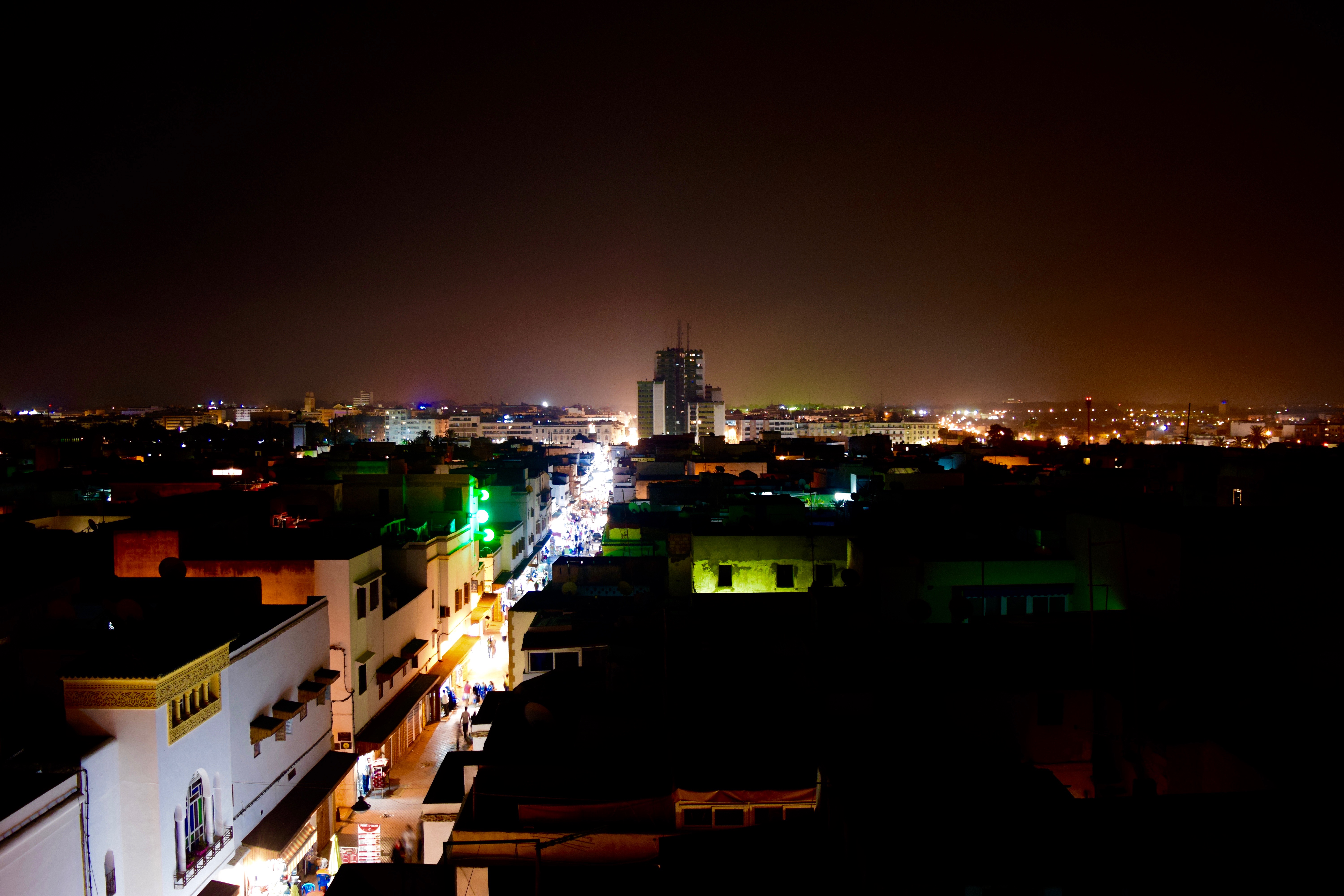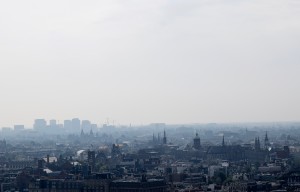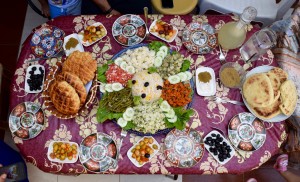
Rabat – Eid al-Adha is a holiday celebrated every year by Muslims to commemorate the end of Ramadan. Every year on this day, Muslim families slaughter a healthy ram and then feast. Traditionally, 1/3 of the food is donated to poor families that can’t buy a ram of their own to sacrifice. I was greeted yesterday morning by two full grown rams tethered outside of my room, one white, one brown. They shuffled their feet apologetically and uttered a few meek “baaaaa’s.”
This morning I slept in, and then began the day with sweet marzipan pastries and mint tea. Extended family from all over the country came to join in on the festivities, and the mood was good. This was followed by a mid-morning nap, and then a cup of coffee.
All of the sudden a man in a white lab coat stained with blood was knocking on the door. He wore a worn in fedora and had thick calluses on his hands. He introduced himself as Abdel, and after a few minutes of small talk he proceeded to empty his bag onto the kitchen table. Ten different knives, three blade sharpeners, and a small hatchet were placed gently on the linen.
The first ram was killed while I was in the bathroom. I heard a loud gurgle and came running out to see blood coursing over the terrace, and the ram kicking on the ground. The butcher was methodical and efficient; separating head from body and skin from carcass.
The front hooves were cut off without much resistance and tossed to the side, while the back ankles were delicately sliced length wise and then snapped, breaking the bone but leaving the tendon intact. Three men then hauled the ram up and hung it from this exposed tendon.
The butcher sliced along the ram’s belly and began coiling the intestines out like so many feet of rope. He entered the ram’s belly up to his elbow and emerged with what I think was the stomach. The chest was slit open and more blood poured onto the tile.
My host family asked me to help in the second slaughter; I was recruited to hold the ram’s hooves in place while the butcher took a knife to his neck. This was by far the more expensive ram. He boasted pearl white skin, massive black horns, and a thick muscular frame. This ram had watched quietly as his comrade was dismantled, and didn’t seem to mind his fate. His chest panted furiously, but besides that he looked almost at peace. The butcher pinched his jugular between two fingers and surgically sliced his throat.
The blood literally gushed from the wound, pulsing out with the last pumps of his powerful heart. As the last moments of life came coursing from his exposed throat, the ram’s body made a few involuntary convulsions, staining his white coat red as convulsed in a pool of his own blood.
I felt a little sick after the proceedings, so I told my host mom that I wanted to go for a walk. The fresh air cleared my head, and the smell of iron was swept from my nostrils. The usually busy souk was all but deserted. All of the store fronts were closed for the holiday, and the only people on the streets were small groups of men circled around fires.
Upon closer inspection I realized that the fires were for burning the decapitated heads of all the rams sacrificed throughout the Medina. Boys laughed gleefully as they emptied the contents of a bottle of lighter fluid onto the head of a ram and then set it ablaze. Blackened heads littered the ground at their feet, and I was greeted with shouts of “Aid Mubarak!”

My first reaction to the holiday was disgust.
The rams shit and piss in the house for a day before their blood is spilled, and then the family proceeds to eat the entrails and brain before the beast has been fully bled. The children watch gleefully as their fathers slap each other on the back with blood covered hands, and their mothers shuffle from the kitchen to the dining room in blood soaked sandals. The next morning, I have been warned that the waves in the ocean have a red tinge, because of poorly designed drainage systems that funnel the blood of thousands of rams directly into the ocean. The smell of fur burning on open street fires stays in the air for days, and vendors sell dried intestines for the next week.
But that is too simple a reaction. It definitely is gross, but it’s also beautiful in its own way.
The night before the slaughter, I was invited by my host sister to join the women of the family painting their hands with Henna. We drew circles on our palms, which seemed to be loaded with religious symbolism, though I don’t know what it was. They then proceeded to paint the ram’s foreheads with the orange dye and pet them while the rams ate and drank deeply.
I left the slaughter feeling a little bit sad, but also a little bit happy. This is what happens every time you eat meat. I’m glad that I don’t have to see this happen every time I make a late night run to McDonalds, or buy 20DH Shwarma in the Souk, but I’m also glad that I did see it happen this time.
It’s disgusting, it stinks, there are so many little things about the process that you would never expect to be disgusted by (the noise that the ankle bone makes when it snaps) but I think it’s better to see it happen. It’s better to know the sacrifice that the animal made before you chomp down. Before we began the evening meal of barbecued kebabs, freshly baked holiday bread, assorted olives, and too many vegetable dishes to name, we all went around the table and said thank you. Some of the relatives said there piece in French, some in Fus’ha, some in Derija.
This was definitely a day of intense culture shock, but it was also a day of learning. Or something.
Happy eating, Eid Mubarak!
Eid al-Fitr is a holiday celebrated every year by Muslims to commemorate the end of Ramadan. Every year on this day, Muslim families slaughter a healthy ram and then feast. Traditionally, 1/3 of the food is donated to poor families that can’t buy a ram of their own to sacrifice. I was greeted yesterday morning by two full grown rams tethered outside of my room, one white, one brown. They shuffled their feet apologetically and uttered a few meek “baaaaa’s.”
This morning I slept in, and then began the day with sweet marzipan pastries and mint tea. Extended family from all over the country came to join in on the festivities, and the mood was good. This was followed by a mid-morning nap, and then a cup of coffee.
All of the sudden a man in a white lab coat stained with blood was knocking on the door. He wore a worn in fedora and had thick calluses on his hands. He introduced himself as Abdel, and after a few minutes of small talk he proceeded to empty his bag onto the kitchen table. Ten different knives, three blade sharpeners, and a small hatchet were placed gently on the linen.
The first ram was killed while I was in the bathroom. I heard a loud gurgle and came running out to see blood coursing over the terrace, and the ram kicking on the ground. The butcher was methodical and efficient; separating head from body and skin from carcass.
The front hooves were cut off without much resistance and tossed to the side, while the back ankles were delicately sliced length wise and then snapped, breaking the bone but leaving the tendon intact. Three men then hauled the ram up and hung it from this exposed tendon.
The butcher sliced along the ram’s belly and began coiling the intestines out like so many feet of rope. He entered the ram’s belly up to his elbow and emerged with what I think was the stomach. The chest was slit open and more blood poured onto the tile.
I was engrossed in the process, and watched feverishly during the second slaughter. This was by far the more expensive ram. He boasted pearl white skin, massive black horns, and a thick muscular frame. This ram had watched quietly as his comrade was dismantled, and didn’t seem to mind his fate. Two men grabbed his hooves and held him on his side. His chest panted furiously, but besides that he looked almost at peace. The butcher pinched his jugular between two fingers and surgically sliced his throat.
The blood literally gushed from the wound, pulsing out with the last pumps of his powerful heart. As the last moments of life came coursing from his exposed throat, the ram’s body made a few involuntary convulsions, staining his white coat red as convulsed in a pool of his own blood.
I felt a little sick after the proceedings, so I told my host mom that I wanted to go for a walk. The fresh air cleared my head, and the smell of iron was swept from my nostrils. The usually busy souk was all but deserted. All of the store fronts were closed for the holiday, and the only people on the streets were small groups of men circled around fires.
Upon closer inspection I realized that the fires were for burning the decapitated heads of all the rams sacrificed throughout the Medina. Boys laughed gleefully as they emptied the contents of a bottle of lighter fluid onto the head of a ram and then set it ablaze. Blackened heads littered the ground at their feet, and I was greeted with shouts of “Aid Mubarak!”
My first reaction to the holiday was disgust.
The rams shit and piss in the house for a day before their blood is spilled, and then the family proceeds to eat the entrails and brain before the beast has been fully bled. The children watch gleefully as their fathers slap each other on the back with blood covered hands, and their mothers shuffle from the kitchen to the dining room in blood soaked sandals. The next morning, I have been warned that the waves in the ocean have a red tinge, because of poorly designed drainage systems that funnel the blood of thousands of rams directly into the ocean. The smell of fur burning on open street fires stays in the air for days, and vendors sell dried intestines for the next week.
But that is too simple a reaction. It definitely is gross, but it’s also beautiful in its own way.
The night before the slaughter, I was invited by my host sister to join the women of the family painting their hands with Henna. We drew circles on our palms, which seemed to be loaded with religious symbolism, though I don’t know what it was. They then proceeded to paint the ram’s foreheads with the orange dye and pet them while the rams ate and drank deeply.
I left the slaughter feeling a little bit sad, but also a little bit happy. This is what happens every time you eat meat. I’m glad that I don’t have to see this happen every time I make a late night run to McDonalds, or buy 20DH Shwarma in the Souk, but I’m also glad that I did see it happen this time.
It’s disgusting, it stinks, there are so many little things about the process that you would never expect to be disgusted by (the noise that the ankle bone makes when it snaps) but I think it’s better to see it happen. It’s better to know the sacrifice that the animal made before you chomp down. Before we began the evening meal of barbecued kebabs, freshly baked holiday bread, assorted olives, and too many vegetable dishes to name, we all went around the table and said thank you. Some of the relatives said there piece in French, some in Fus’ha, some in Derija.
This was definitely a day of intense culture shock, but it was also a day of learning. Or something.
Happy eating, Eid Mubarak!






